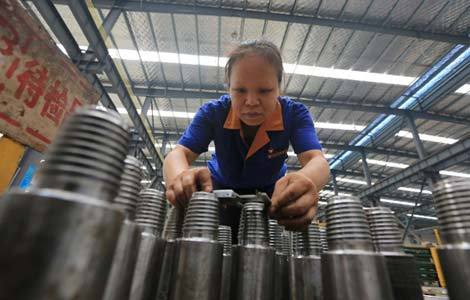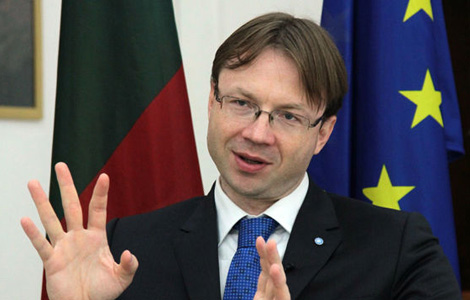Joint China-US Economic Track Fact Sheet
Updated: 2013-07-17 06:20
(US Department of Treasury)
|
|||||||||
FIFTH MEETING OF THE U.S.-CHINA STRATEGIC AND ECONOMIC DIALOGUE
JOINT US-CHINA ECONOMIC TRACK FACT SHEET
As the Special Representatives of President Barack Obama and President Xi Jinping, US Treasury Secretary Jacob J. Lew and Chinese Vice Premier Wang Yang led the fifth meeting of the Economic Track of the US-China Strategic and Economic Dialogue (S&ED) in Washington, DC, July10-11. They were joined by a high-level delegation of Cabinet members, ministers, agency heads, and senior officials from both countries.
Early this June, President Obama and President Xi held a historic meeting in California, which set the strategic tone and direction for the development of the US-China relationship. This meeting of the S&ED provided an opportunity to implement that strategic framework through concrete progress and to generate practical cooperation on issues across the economic relationship, for the benefit of our two economies and for the global economy.
The United States and China emphasized the importance of promoting a comprehensive US China economic relationship based on mutual respect and mutually beneficial cooperation. The two countries reaffirmed the important commitments pledged by both countries in previous Strategic and Economic Dialogues. The two countries announced further concrete measures to support strong domestic and global growth, promote open trade and investment, enhance international rules and global economic governance, and foster financial market stability and reform. The two countries reached consensus to work expeditiously to implement the commitments made and, as the Special Representatives of the Economic Track, directed their respective economic teams to take concrete steps before the next Strategic and Economic Dialogue to do so.
I. Strengthening Economic Policy
Since the fourth meeting of the S&ED in May 2012, the United States and China have taken significant actions to strengthen growth and employment creation in both countries, foster a durable global recovery, and ensure that the pattern of their domestic growth supports strong, sustainable, and balanced global growth.
• Both sides commit to implement our G-20 commitments to move more rapidly toward more market-determined exchange rate systems and exchange rate flexibility to reflect underlying fundamentals, avoid persistent exchange rate misalignments, and to refrain from competitive devaluation. China is to continue exchange rate reform, increase flexibility of RMB exchange rate, and let market play a more fundamental role in the exchange rate formation.
• Both sides discussed the positive feedback between enhancing data transparency and financial stability and facilitating China’s efforts to subscribe to the Special Data Dissemination Standard (SDDS). They noted this process could be facilitated by reporting reserve data in Special Drawing Rights (SDRs) and the inclusion of additional currencies in the SDR basket when they meet existing criteria. China is actively considering subscription to the SDDS.
• Consistent with its statutory mandate, the US Federal Open Market Committee (FOMC) seeks to foster maximum employment and price stability. To support continued progress toward meeting its mandate, the FOMC has been pursuing a highly accommodative monetary policy, including the purchase of longer-term Treasury and agency mortgage-backed securities. In determining the size, pace, and composition of its asset purchases, the FOMC continues to take appropriate account of the likely efficacy and costs of such purchases as well as the extent of progress toward its economic objectives. The Federal Reserve is sensitive to the effects of its polices on the international financial system. A key goal of the Federal Reserve is to maintain financial stability both domestically and internationally.
• China commits to advance market-based interest rate reform, including by developing a market-based benchmark interest rate system, improving monetary policy transmission, expanding pricing flexibility and strengthening pricing capacity of market participants, and letting the market play a more important role in credit allocation.
• In order to increase rural and urban residents’ income, gradually narrow the gap of income distribution, improve the way and pattern in which income is distributed, China is to deepen the reform of the income distribution regime, further improve the primary distribution mechanism, and accelerate the improvement of redistribution adjustment mechanism through fiscal and other policies. China is to increase social security and employment spending as a percent of fiscal expenditures by about two percentage points during the 12th Five-Year-Plan period. China is to reform the land acquisition system, guarantee farmers’ legal rights and interests pursuant to law and raise the farmers’ share in the distribution of land’s value-added benefits.
• To support further rebalancing of the US economy, the United States remains committed to moving toward a medium and long term pattern of growth characterized by increased investment and higher national savings, including through reduction of the federal budget deficit.
• The United States remains committed to putting public finances on a sustainable path over the medium term. The Administration is committed to building on the more than $2.5 trillion in already-enacted deficit reduction by replacing the sequester with a balanced package of additional deficit reduction measures. The Administration’s deficit reduction plan would put the debt-to-GDP ratio on a declining path beyond 2015, and lower the deficit to about 2 percent of GDP by 2023.
• China remains committed to actively pushing forward the integration reform of the services sector business tax into the Value-Added Tax (VAT) and to extend the VAT reform nationwide to all service sectors. By the end of this year or early 2014, China is to extend the nationwide pilot scheduled to start August 1 to include the railway transport, postal, and communication sectors.
• China is to speed up the reform of its state-owned-enterprises (SOEs), and further spin-off social functions and the management of retired SOEs workers’ benefits, etc. Based on the reform, and consistent with the requirements of the income distribution reform, China is to continue increasing the dividend payout ratio of central state-owned enterprises, and to increase the size of dividend revenue to be spent on social security and people’s welfare.
• China publishes reports on an annual basis containing relevant information on the state capital operational budget according to the Budget Law and relevant regulations on government information disclosure. China is to further improve the procedure of the state capital operational budget disclosure and provide more detailed information, including on budget allocation, in accordance with the requirement of government information disclosure.
• China remains committed to ensuring that economic entities under all forms of ownership have equal access to factors of production in accordance with the law, compete on a level playing field, and are treated equally by the law. China is to develop a mechanism for determining the prices of factors of production mainly by the market.
• The United States and China affirm the importance of the rule of law to protecting legitimate commercial expectations, providing economic stability in their commercial relationship, and establishing a foundation for development of an innovative economy. The United States and China affirm that legal cooperation and exchanges are in the interest of both countries and commit to work together to improve the legal environment in their countries.
• The United States and China commit to support the development of a sound, market based, green, and low-carbon economy through appropriate economic policies, and to strengthen communication and seek opportunities for cooperation on the following: fiscal policies that promote energy-saving and environment protection, price and fee reforms on resources products, and Public-Private-Partnership (PPP) to support low-carbon economic development.
• The two sides welcome opportunities for cooperation on their economic agendas. China is to promote the process of industrialization, urbanization, informatization and agricultural modernization, and welcomes information exchange, experience sharing, and practical cooperation with the Unites States as appropriate. The two sides commit to further strengthen macroeconomic communication and cooperation, and to discuss important economic policies with each other in a timely manner.
• The two sides are committed to maintain international economic and financial stability, and support the steady recovery and growth of the world economy. The United States and China are committed to continuing to exchange views on developments in European financial markets and encourage European leaders to further strengthen the foundations of their economic and monetary union. The two sides also exchanged views on economic developments in Japan and noted the importance of Japanese efforts to reinvigorate growth and escape deflation through policies that work through domestic demand, and emphasized that structural reform measures are a critical part of this process.
II. Promoting Open Trade and Investment
The United States and China emphasized the importance of fostering an open and fair trade and investment relationship, recognizing that doing so is critical to economic growth and job creation in both countries and in the global economy. The United States and China commit to take the following measures to enhance our bilateral trade and investment relationship, to support an open and fair environment, and create greater opportunities for US and Chinese companies and workers.
• The United States and China recognize that a Bilateral Investment Treaty (BIT) that sets high standards, including openness, non-discrimination, and transparency, would be important to both sides, and welcome the progress made in the BIT negotiations to date. The two sides reaffirm their shared commitment to enhance openness, accord fair and equitable treatment, and contribute to the reduction or elimination of discriminatory practices and market barriers. After nine rounds of technical discussions, China is to enter into substantive BIT negotiations with the United States. The BIT will provide national treatment at all phases of investment, including market access (“pre-establishment”), and be negotiated under a “negative list” approach.
• Recognizing the importance of trade secret protection to maintaining fair competition and to the development of an innovative economy, the United States and China commit to provide vigorous protection and enforcement of trade secrets, and to strengthen procedures and remedies according to law. The United States and China also commit to strengthen cooperation and exchange of information, including relevant enforcement data, through the JCCT.
• The United States commits to give fair treatment to China during its export control reform process and to consider China’s concerns seriously by promoting and facilitating bilateral high-tech trade with China of commercial items for civil end uses and civil end users. Both sides reaffirm to work through the US-China High Technology Working Group (HTWG) to discuss export control issues.
• China is to further promote the use of legal software by SOEs, including by strengthening supervision of central SOEs and large state-owned financial institutions by establishing software asset management systems (SAM); enforcing China’s requirement to purchase and use legitimate software by these SOEs; providing budget guarantees for software and promoting centralized procurement. The United States and China are to strengthen cooperation to address technical implementation issues, in order to consolidate the software legalization achievements.
• The United States and China commit to continuing to consult through the appropriate JCCT working group in a cooperative manner to work toward China’s Market Economy Country Status in an expeditious and comprehensive way.
• China is to establish a policy review mechanism, under which the US Trade Representative and Department of Commerce may convey at any time to the Chinese Ministry of Commerce (MOFCOM) any regulations, rules, and regulatory documents, at the central and local governments, that contain language that the United States believes is inconsistent with China’s multilateral or bilateral commitments. MOFCOM is to engage with the relevant Chinese agencies to investigate and make any corrections, if necessary.
• China affirms that the National Leading Group on Combating IPR Infringement and the Manufacture and Sales of Counterfeit and Substandard Goods is to take effective measures to push forward improvements of legislation, improve cross-regional and inter-agency enforcement cooperative mechanisms, and strengthen actions to fight counterfeiting and piracy. The United States and China affirm, with a particular focus on combating Internet piracy, to crack down on all kinds of illegal activities of infringement and counterfeiting, foster a better environment for the increased sales of legitimate IP intensive products and services, including software, and jointly study and exchange information on how to accomplish this objective.
• The United States and China commit to discuss issues concerning China raised in the Consolidated and Further Continuing Appropriation Act, 2013.
• China is to submit a new revised offer to the WTO Government Procurement Committee by the end of 2013, which responds to US and other GPA parties’ requests including lowering thresholds, increasing coverage of sub-central entities, and improvements in other areas. China is to submit a new revised GPA offer with broader coverage as soon as possible, based on the domestic reform progresses in relevant areas, which will take the requests of the GPA parties into consideration. The United States and China is to exchange lists of questions on both countries’ procurement systems and the requirements of the GPA that will form the basis for on-going technical discussions beginning this summer.
• China reaffirmed its commitment made in S&ED IV to implement a more proactive opening up strategy for foreign investment. China is now actively studying measures on further proactively opening up of services sectors, including establishing the Shanghai Free Trade Zone pilot, which is to implement a new foreign capital administrative model on a trial basis, and create a market environment that provides equal access for all types of enterprises, domestic and foreign. In addition, China is actively considering to further open up more areas including e-commerce and commercial factoring.
• China is to actively promote reform of its administrative review and approval system, transform government functions, and reduce micro-affair management. China is to gradually decrease and decentralize its foreign investment reviews and approvals as an important part of the reform. China is to minimize the scope for such reviews and approvals, promote independent investment decision making by enterprises and individuals, and further improve the level of investment facilitation.
• The United States and China are to explore common interests in multilateral and regional contexts, including the WTO and the Asia-Pacific Economic Cooperation (APEC), and continue strengthened information exchange on issues in the WTO and on the process of FTA development.
• The United States commits that all investment reviews by the Committee on Foreign Investment in the United States (CFIUS) focus exclusively on national security, not economic or other national policies. When a transaction poses a national security risk, CFIUS works to resolve it as expeditiously as possible, including through targeted mitigation rather than prohibition whenever possible. In its public Annual Reports, CFIUS generally describes national security considerations presented by transactions it has reviewed, as well as the perceived adverse effects of transactions on the national security or critical infrastructure of the United States that CFIUS will take into account in its deliberations during the next reporting period, to the extent possible. The two sides commit to continue to discuss key concepts and factors in the US foreign investment review including discussion in the US-China Investment Forum.
• The United States welcomes investment from all countries, including China. The United States reaffirms our open investment policy and a commitment to treat investors in a fair and equitable manner under the law. The United States commits to maintain an open investment environment for Chinese investors, including SOEs, as with investors from other countries.
• The United States and China commit to administer anti-dumping and countervailing duty investigations in a fair, objective and transparent manner. Both sides recognize that it is critical to follow WTO rules when undertaking trade remedy investigations or imposing trade remedy measures, to prevent their abuse.
• The United States and China commit to resume and continue regular meetings at the vice minister and working levels beginning no later than mid-December 2013 and preparatory working level engagement a month in advance, to promote transparency by identifying ways to enhance predictability for market participants and promote confidence in our economies.
• The United States and China confirm that all administrative licensing regimes at the central and sub-central government levels are to be based on applicable laws, regulations, and rules, and that all such measures establishing administrative licensing regimes are to be publicly available.
• The United States reaffirms its commitment to upholding the open and non-discriminatory principles toward sovereign wealth funds as described in the Declaration on Sovereign Wealth Funds and Recipient Country Policies announced by the OECD in June 2008. China reaffirms its commitment to follow the generally accepted principles and practices of Sovereign Wealth Funds.
• The United States and China recognize the potential for their firms to play a positive role in infrastructure financing in each country, and commit to explore opportunities for deepening cooperation, including through the US-China Investment Forum. To that end, the United States and China commit to continue to utilize the US-China Investment Forum as a platform to strengthen communication and exchanges between US and Chinese investment policy makers.
• The United States and China are committed to supporting and facilitating sub-national cooperation at the city and local levels. Such cooperation between the two countries at the sub-national level can lead to mutually beneficial trade and investment opportunities. Building on the two successful US-China Conferences on City-Level Economic Cooperation, The United States and China commit to support continued engagement that promotes investment cooperation between cities and enterprises of the two countries, including holding a 3rd U.S.-China Conference of City-Level Economic Cooperation as soon as possible, preferably this year.

 Free on his feet
Free on his feet
 Extreme heat causing vehicle fires
Extreme heat causing vehicle fires
 Men, you look good in slim elegant cut
Men, you look good in slim elegant cut
 Luxury dresses in plastic
Luxury dresses in plastic
 Obama urges restraint amid protests
Obama urges restraint amid protests
 Putin wants Snowden to go, but asylum not ruled out
Putin wants Snowden to go, but asylum not ruled out
 Apple to probe death of Chinese using charging iPhone
Apple to probe death of Chinese using charging iPhone
 Investment falters as industrial activity flags
Investment falters as industrial activity flags
Most Viewed
Editor's Picks

|

|

|

|

|

|
Today's Top News
Premier highlights economic restructuring
Baidu to acquire biggest app store
China signs co-op pact with Belarus
Studies using humans must be registered
Summer heat leaves cities gasping
River polluters handed prison terms
Ministry plans to beef up investment
Drivers lose out on fee hike
US Weekly

|

|






